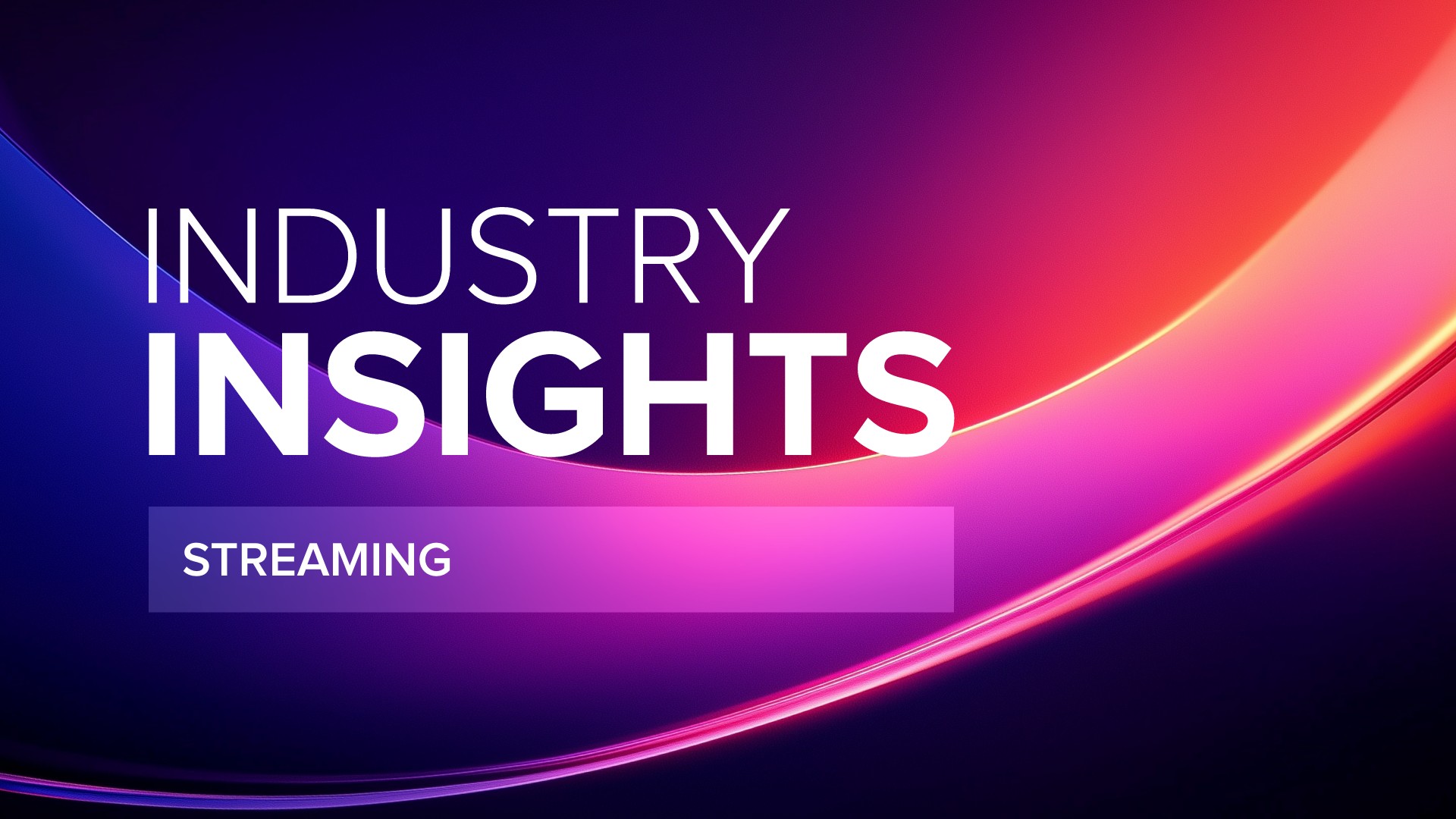Industry Insights: Future of streaming shaped by AI, data and infrastructure shifts

Subscribe to NCS for the latest news, project case studies and product announcements in broadcast technology, creative design and engineering delivered to your inbox.
next genAs streaming continues to redefine media consumption, the next wave of innovation will be shaped by emerging technologies, new partnerships, regulatory changes and evolving viewer expectations.
In the final installment of our four-part Industry Insights series on streaming, we explore what’s ahead for the sector. Topics include the impact of AI and XR, the critical role of first-party data, how telco and broadcast convergence could reshape content distribution and the looming challenges around privacy, security and sustainability.
Industry leaders weigh in on how bandwidth expansion, hyper-personalization, and regulatory shifts will set the course for the future—and what media companies must prioritize to stay competitive in a rapidly changing landscape.
Key takeaways from this Industry Insights roundtable
- Emerging technologies accelerate change: Innovations like AI, XR, edge computing, and 8K streaming are enhancing viewer experiences and transforming operational workflows.
- First-party data takes center stage: As third-party cookies decline, the ability to collect and leverage first-party data is becoming critical for personalization and monetization.
- Telecom and broadcast lines blur: Partnerships between telcos, broadcasters, and cloud providers are reshaping content distribution models, offering new efficiencies and revenue opportunities.
- Regulatory shifts drive adaptation: New rules around local content, privacy, and audio standards will require streamers to rethink content strategies and compliance frameworks.
- Sustainability and cost control rise in importance: Media companies must address carbon footprints and hidden infrastructure costs to ensure long-term viability and competitiveness.
How will emerging technologies shape future streaming experiences?
Costa Nikols, strategy advisor, M&E, Telos Alliance: The nature of streaming lends itself to the implementation and regular improvement of technology, which can vastly enhance viewer experiences. For example, picture quality has advanced so dramatically that, in many instances, home viewing is more immersive than attending a live event. Next Generation Audio (NGA) adds another sensory dimension, making the experience even more realistic.
Anupama Anantharaman, VP, product management, Interra Systems: From Interra Systems’ perspective, the use of AI/ML for predictive analytics and automation is helping streaming service providers improve workflow efficiency and the reliability of their product offerings. These multiple aspects of streaming, from compression and content classification to consumer behavior analysis and monetization. These tools are capable of analyzing viewer behaviors and preferences in real-time, empowering platforms to dynamically customize content, recommend personalized playlists, and even modify user interfaces to suit individual preferences.
Andrew Ward, business development manager, Cinegy: Bandwidth expansion is the game-changer across the entire chain. In broadcast environments, we’re seeing migration from one gigabit to 10, 25, 40, and even 100 gigabit networks, dramatically accelerating production workflows. Meanwhile, metropolitan areas increasingly have access to high-speed connections — I personally have two glass fiber connections to my house sharing the network, which gives me four gigabit symmetric speeds. This bandwidth availability enables entirely new content presentation methods.
Kev McCormick, product experience lead, Accedo: One of the most exciting emerging technologies is XR. XR is often met with a certain level of skepticism, perhaps partly driven by the look and bulkiness of devices, but it almost always disappears the moment you try it for yourself and from what our team has seen at recent trade shows, every year the tech’s getting smaller, slicker, and way more capable. For sport in particular, XR opens the door for in-stadium and at-home experiences that cater to superfans.
Aaron Kroger, product marketing lead, Dalet: Emerging technologies are set to redefine streaming, with AI-driven hyper-personalization delivering tailored content and edge computing enabling ultra-low latency for superior live and interactive experiences. Innovations like 8K streaming and multi-camera views elevate visual quality and engagement, while interactive storytelling features transform passive viewing into dynamic, immersive participation. As these technologies mature, they will bridge gaps between content creators and audiences, fostering richer, more adaptable streaming ecosystems.
Eric Gallier, VP, video solutions, Harmonic: Emerging technologies like AI and hybrid cloud/on-premises architectures are fundamentally reshaping the future of streaming. AI is enabling greater efficiency, from automated subtitles powered by speech-to-text AI, automated closed captioning, AI-driven sports clipping for real-time highlight creation, automatic detection of ad insertion markers and real-time translation with voice cloning or over-dubbing in any language. At the same time, hybrid infrastructures give service providers the flexibility to optimize performance and cost by balancing cloud scalability with on-prem control.
What role does first party data play in the future of streaming?
Cees van Versendaal, COO, MwareTV: Evolving privacy regulations and increasing sophistication in browser ad blockers is pushing streamers away from third-party data. Personalization remains a powerful tool in audience retention, though, so operators must prioritize their first-party data use, within the data regulations and legal frameworks of their markets.
Hadar Tel Mizrahi, senior product manager, targeted ads and recommendations, Viaccess-Orca: First-party data provides a secure, compliant way to maintain effective audience targeting. It is now critical for hyper-targeted personalization, subscriber retention, content recommendations, and enabling privacy-compliant advertising strategies as third-party cookies decline.
Peter Mayhead, CEO, Pebble: There is huge potential for closely targeted content, and particularly advertising, by knowing all there is to know about your subscribers. Carefully handled, this has benefits: audiences are much more tolerant of advertising if it is all relevant to them. But consumers are now very wary of online businesses knowing too much, and too much targeting can be a literal turn-off.
What potential partnerships or collaborations could redefine content distribution?
Paul Calleja, CEO, GlobalM: Broadcasters, cloud providers, and telecom companies working together can improve content distribution by making it more efficient and cost effective. AI driven analytics can help content creators make smarter decisions and tailor their programming to audiences. There are also new opportunities in interactive and shoppable video, which create fresh ways to engage viewers and generate revenue.
Andrew Ward: We’re already witnessing telecommunications companies entering the playout space, in France, Australia, India, Portugal and beyond where telcos are taking on broadcast responsibilities. Looking ahead, we expect increasing unification between telecommunications providers and broadcasters as their functions essentially merge. The distinction between content creation, distribution, and delivery is blurring rapidly, with the technical infrastructure becoming increasingly shared across these previously separate domains.
Dee McVicker, marketing director, Wheatstone: We’re seeing some very interesting partnerships coming together. For example, Wheatstone is all about the studio and the appliances for provisioning, processing and managing the metadata for streams. Companies like Triton are all about providing the CDN services that feed programmatic ad systems. What broadcasters end up with is the seamless integration of both, from streaming integrated into their automation systems as part of their regular studio workflows to content delivery and out to ad exchange marketplaces.
How do you foresee regulatory changes affecting streaming?
Costa Nikols: The inconvenience of inconsistent audio levels is becoming increasingly apparent as more people subscribe to multiple streaming services. The largest regulatory change I anticipate will be the standardization of audio loudness across streaming FAST and SVOD content to address this issue. It’s already frustrating to adjust the volume between streaming apps, but even more so between programs and previews while scrolling on the same service, or during ad breaks on FAST channels.
Roger Franklin, chief strategy officer, LTN: As regulatory shifts threaten satellite availability, content providers are accelerating the move to IP. Media companies that embrace IP for large-scale channel distribution can much more easily customize and version content in real-time, making it easier to deliver more premium news and sports across digital platforms.
Lucas Bertrand, founder and CEO, Looper Insights: Regulatory changes like local content quotas and prominence requirements are set to reshape how streaming services operate, especially in markets with strong public broadcasters. Policies such as the UK’s Media Bill aim to level the playing field by ensuring local players maintain visibility alongside global streaming giants. As these rules take hold, streamers will need to adapt content strategies and interface design to meet regional obligations without sacrificing user experience.
What innovations are needed to address data privacy and security in streaming?
Peter Mayhead: If security is not at the top of the agenda for every online business then it should be. Streamers must protect their streams to the home to ensure it is not interrupted: reputations are killed forever if someone tunes in to the football and the stream is interrupted by hacked-in political messaging. Every step of every part of the operation — including subscriber information as well as content acquisition and delivery — must be hardened, audited and audited again.
Tobias Fröhlich, managing director of product, Qvest: Governments worldwide are imposing stricter regulations on digital and media services, particularly concerning data privacy. These regulations significantly impact content production, distribution, and monetization, especially in advertising. Consequently, compliance is becoming increasingly complex but is essential to avoid substantial fines and maintain customer trust. Regulators are stepping in to examine data privacy and content standards more closely, while consumers are voicing their own concerns about how personal information is stored and used.
What are we missing that we should be thinking about or talking about?
Paul Calleja: The carbon footprint of streaming infrastructure, particularly data centers and content delivery networks, is a growing concern. Future innovations should prioritize energy efficient encoding methods, intelligent caching, and eco-friendly CDN strategies to ensure responsible growth in the sector. Also, remote production and reducing staff transport, equipment shipping and logistics can be factored into the carbon footprint of the telecom and data center footprint so a better calculation is made as to if cloud is a benefit or adding to the carbon footprint of the broadcast industry in general.
Cees van Versendaal: The number of streaming providers leads to fierce competition, which inevitably leads to price sensitivity. As the first generation of OTT systems near end-of-life, operators need to be clear about what is going to offer the functionality they require for highly efficient operations, the agility to respond instantly to new ideas and changing markets, and an optimized total cost of ownership which provides a predictable and affordable operational expenditure against which to build revenues.
Peter Mayhead: To compete against legacy broadcasters, and the big established names in streaming, service operators have to be agile, identifying market opportunities and getting to market very quickly. We are all used to finding a need, downloading an app to meet it, and solving the issue within minutes. Streaming technology — and in particular asset management and delivery — has to have that sort of instant flexibility, to be able to try something and, if it works, build infrastructure around it.
Andrew Ward: The infrastructure is robust, with high-speed networks and powerful computing resources widely available. The real issues facing the industry involve adaptation, adoption, and restructuring content for new consumption patterns. Dedicated video and broadcast hardware is obsolete, the future is software on standard physical, virtual and cloud platforms.
Roger Franklin: Rising egress fees, difficulties in reporting and the complications of orchestrating multi-vendor, cloud-dependent workflows are posing several pain points for media businesses, particularly in high-demand areas like FAST channel creation and delivery. Content owners need confidence that the cost of launching new digital channels aligns with expected revenue returns. That means reducing unnecessary expenses and the hidden costs often baked into public cloud environments in favor of more controlled, purpose-built IP alternatives.
Subscribe to NCS for the latest news, project case studies and product announcements in broadcast technology, creative design and engineering delivered to your inbox.





tags
Aaron Kroger, Accedo, AI, Andrew Ward, Anupama Anantharaman, Artificial Intelligence, Cees van Versendaal, Cinegy, Costa Nikols, Dalet, data, data analytics, Dee McVicker, dynamic ad insertion, Eric Gallier, Extended Reality, Free Ad-Supported Streaming Television (FAST), GlobalM, Hadar Tel Mizrahi, Harmonic, Interra Systems, Kev McCormick, Looper Insights, LTN, Lucas Bertrand, MwareTV, Next Generation Audio (NGA), Paul Calleja, Pebble, Peter Mayhead, Qvest, Roger Franklin, Telos Alliance, Tobias Fröhlich, Triton, Viaccess-Orca, Wheatstone
categories
Heroes, Industry Insights, Policy, Streaming, Voices